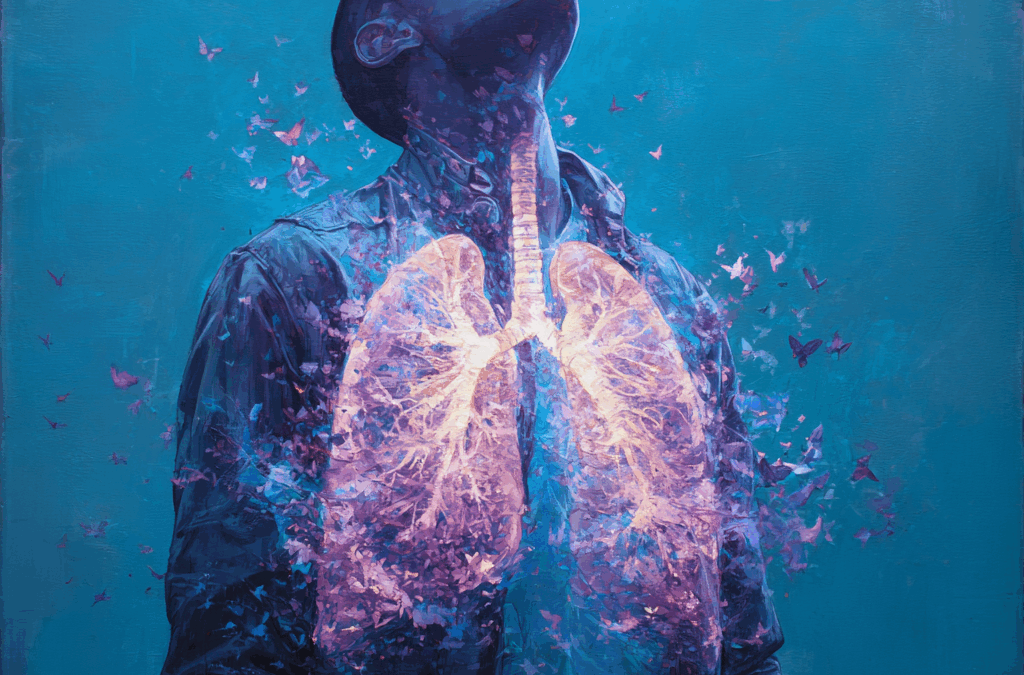
The Miracle of Breathing – Ch 1 – Breathe to Heal: How Nutrition and Lifestyle Can Save Your Lungs
Chapter 1: The Miracle of Breathing
Breathe to Heal: How Nutrition and Lifestyle Can Save Your Lungs
You can go weeks without food, days without water — but only minutes without breath.
Breathing is the first thing you do when you enter this world, and the last thing you do when you leave it.
In between, it’s the rhythm that sustains every heartbeat, thought, and cell in your body.
Yet despite its power, breathing is the one thing we take most for granted.
We forget that each breath isn’t just air — it’s life in motion.
🫁 The Hidden Intelligence of Your Lungs
Your lungs are not just sacks of air. They are among the most complex and intelligent organs in your body — intricately designed to filter, exchange, and nourish.
Inside your chest are over 300 million alveoli, tiny balloon-like air sacs surrounded by an incredible network of capillaries.
Spread flat, this surface area equals about the size of a tennis court — all packed neatly inside your ribcage.
With each inhale, oxygen molecules travel down into these microscopic chambers, where they meet red blood cells and bind to hemoglobin.
In a split second, oxygen enters your bloodstream, fueling your brain, heart, and every living tissue in your body.
And on every exhale, carbon dioxide — a byproduct of metabolism — is released. This exchange happens roughly 25,000 times per day without you ever noticing.
When your lungs function well, they are a silent symphony of precision. But when inflammation, pollution, or stress disrupt that rhythm, the entire body feels it.
🧬 The Breath-Body Connection
Breathing is more than a mechanical process — it’s the translator between your body and your emotions.
When you’re anxious, your breath shortens.
When you’re calm, it deepens.
When you exercise, it accelerates to deliver more oxygen to your muscles.
This feedback loop between the lungs, brain, and nervous system is what scientists call the “respiratory-cardiac axis.”
-
When you inhale deeply, your heart rate slightly increases.
-
When you exhale slowly, it decreases.
This natural rhythm — known as respiratory sinus arrhythmia — synchronizes your heart and breath like partners in a dance.
It’s the biological foundation of calm.
That’s why techniques like meditation, yoga, and pranayama focus on lengthening the exhale — it directly activates the parasympathetic nervous system, your body’s built-in relaxation mode.
In other words: how you breathe determines how you feel.
🌿 Breathing Feeds Every Cell You Have
Oxygen is the currency of life. Every cell in your body depends on it to generate energy through a process called cellular respiration.
Without oxygen, your cells cannot produce adenosine triphosphate (ATP) — the molecule that powers all biological activity.
Even small reductions in oxygen levels can trigger fatigue, brain fog, and inflammation.
That’s why people who practice deep breathing often report higher energy, better focus, and emotional stability.
They’re not imagining it — they’re literally improving cellular efficiency.
But here’s what most people don’t realize:
Your ability to absorb and use oxygen isn’t fixed.
You can train your lungs, diaphragm, and circulation system to become stronger — just like a muscle.
Research from Harvard and the Cleveland Clinic shows that breathing exercises can:
-
Increase lung capacity by up to 20%
-
Lower resting heart rate and blood pressure
-
Reduce inflammatory markers (like CRP and IL-6)
-
Enhance immune cell activity
Breathing, in essence, is your most accessible form of medicine.
💨 The Breathing Spectrum: From Shallow to Superhuman
Most people breathe shallowly — drawing air into the upper chest instead of deep into the diaphragm.
This type of breathing, often caused by stress or posture, limits oxygen intake and activates the sympathetic “fight or flight” response.
Over time, chronic shallow breathing can lead to:
-
Increased anxiety
-
Muscle tension and headaches
-
Poor sleep
-
Impaired digestion
-
Decreased lung elasticity
By contrast, diaphragmatic breathing — also called “belly breathing” — engages the largest muscle of respiration and fully expands the lungs.
It improves oxygen exchange, lymphatic flow, and even massages the organs of the abdomen.
Elite athletes, monks, and singers have long mastered this art — and studies show that it can extend life expectancy by improving cardiovascular and immune function.
Your breath, it turns out, is both a mirror of your current health and a lever for improving it.
🧠 The Mind in the Breath
Your breath also carries an emotional story.
When you’re angry, it’s rapid and hot.
When you’re grieving, it’s uneven and shallow.
When you’re peaceful, it’s smooth and rhythmic.
Every inhale and exhale is a message between the body and brain — a two-way conversation between physiology and psychology.
Neuroscientists have discovered that specific breathing rhythms stimulate regions of the brain linked to mood, attention, and memory.
Controlled breathing can even alter brainwave patterns, helping shift you from anxiety to clarity within minutes.
This is why breathwork is now being used in clinical settings to treat PTSD, depression, and panic disorders — it’s a tool that reconnects the nervous system with the body’s inner calm.
When you breathe consciously, you are no longer a victim of stress. You become its master.
🔬 Breathing and Inflammation: The New Frontier
In recent years, researchers have begun to understand how breathing directly influences inflammation and immunity.
Deep, rhythmic breathing increases levels of nitric oxide — a powerful molecule that opens blood vessels, improves circulation, and kills harmful pathogens in the respiratory tract.
At the same time, slow breathing reduces oxidative stress, which is one of the key drivers of chronic lung disease.
This connection explains why mindfulness, yoga, and meditation all have measurable effects on reducing inflammatory markers in clinical trials.
Your breath is not just a relaxation technique — it’s a biological signal that tells your immune system whether you are safe or in danger.
🌎 The Environmental Factor
Even the best lungs can’t thrive in toxic air.
From polluted cities to wildfire smoke, airborne particles now infiltrate every aspect of modern life. These microscopic invaders — PM2.5, ozone, and nitrogen oxides — trigger inflammation, constrict airways, and increase susceptibility to infection.
This makes it even more essential to strengthen the lungs internally — through antioxidant nutrition, hydration, and mindful breathing practices that support cellular repair.
As the world’s air quality declines, individual lung care becomes a global act of self-preservation.
💡 Key Takeaway: Your Breath Is Your Baseline
Every breath you take carries information about your body’s balance.
If you breathe shallowly, rapidly, or unconsciously — your body interprets life as a threat.
If you breathe deeply, slowly, and rhythmically — your body interprets life as safe.
Your lungs don’t just keep you alive — they teach you how to live.
By understanding and honoring the miracle of breathing, you reclaim control over your most essential function and begin the healing process from within.
🌤️ In the Next Chapter…
We’ll explore why respiratory diseases are skyrocketing across the globe — the environmental, nutritional, and emotional factors driving the modern lung health crisis — and what science reveals about how to reverse it.




